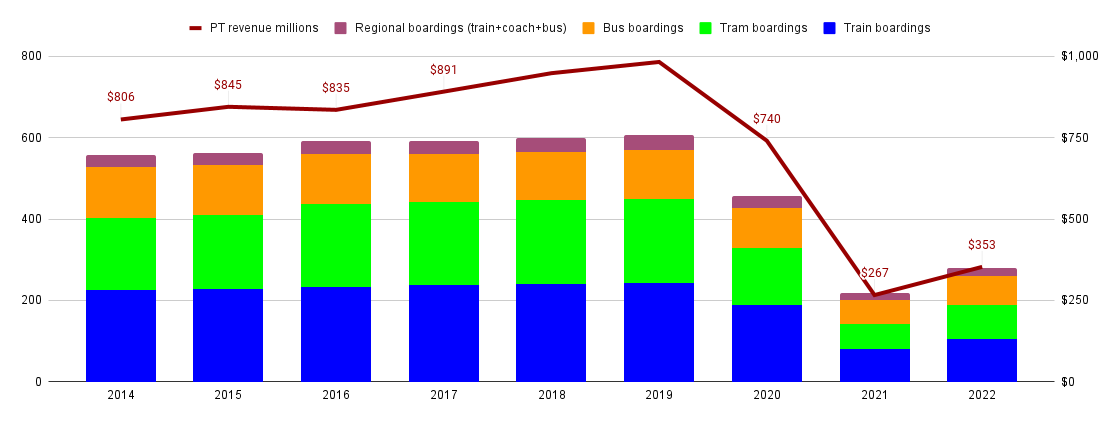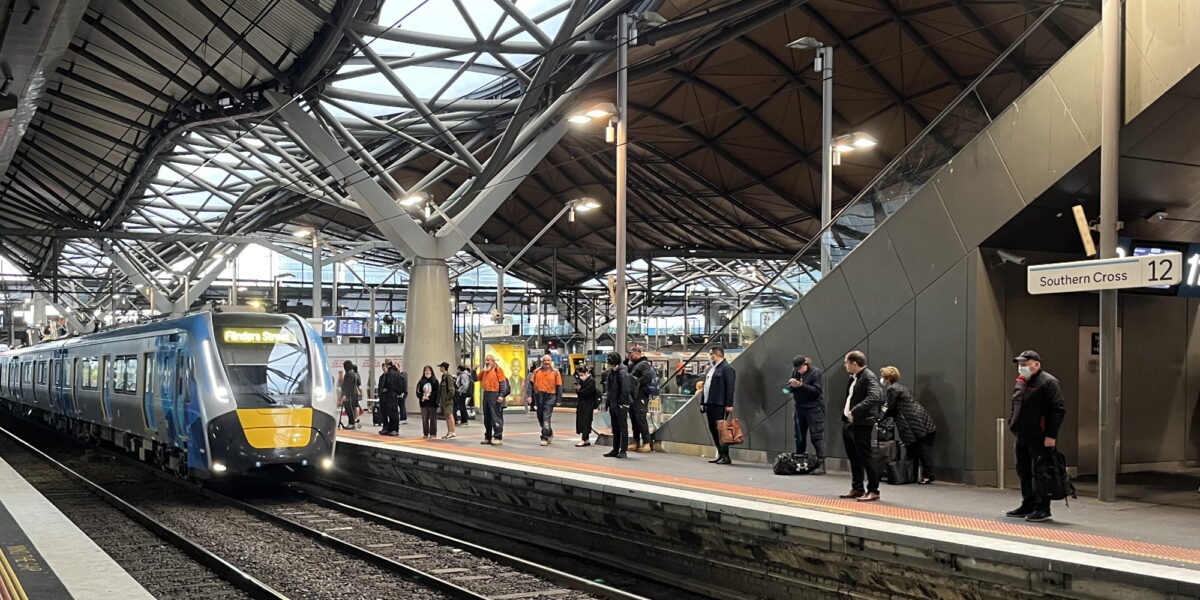I was thinking I would update the chart on public transport patronage and fare revenue – then the State Coalition announced election pledges on fare cuts, which are worth discussing as well.
Let’s start with the chart:

After the dizzying heights of almost a billion dollars of fare revenue in 2018-19, it plummeted after that, down 73% to $267m in 2020-21, thanks to COVID lockdowns.
Patronage and revenue have started to recover. Revenue is back to $353m for 2021-22, with patronage for regional bus (73% of 2018-19) and metropolitan bus (57%) having recovered the most. This probably reflects that buses are more likely to serve people travelling to school, uni and blue collar jobs that can’t be done remotely.
Unfortunately DOT hasn’t been updating the monthly data, so in terms of public information, we don’t have more detail yet on how patronage has recovered through 2022. (Monthly numbers aren’t terrific for this anyway. Weekly or 4-week periods would be better so you can compare apples to apples.)
The Coalition’s pledges
On Sunday the Coalition pledged to cut metropolitan fares to $2 per day – down from typically $9.20. This was costed at $1.3 billion for 4 years.
Cutting fares by 78% is pretty rash. Accounting for other types of fares (including V/Line), it might cut revenue by about 70%, from $353m down to about $105m.
That would mean that the cost of collecting revenue (Myki at about $95m/year, and other costs of perhaps up to $50m) would be more than the revenue itself.
Of course, presumably there would a patronage uplift (on the busy/usable routes) in coming years thanks to the fare cut, and thanks to the ridership recovery which is underway.
Near-free PT is similar to free PT, with similar benefits and problems, which I went into detail on in this blog post in March.
On the same day, the Coalition also made a minor pledge that got near zero attention, to introduce an express bus from Glen Waverley to Box Hill, with a frequent service every 10-15 minutes on weekdays. This would cost $12 million, about one 100th of the fare proposal.
100 of these routes (or upgrades of existing routes to this standard) would have a huge patronage effect, far more than the fare cut.
On Tuesday the Coalition followed up with a plan to cut V/Line fares by half.
Cutting by half is still pretty drastic, but overall this is a more reasonable proposal, which improves affordability without completely trashing the revenue base.
V/Line’s annual reports document their revenue separately to the rest of the public transport network. In 2018-19 it was $102.9m, falling to $76m in 2019-20, then falling to $32.6m in 2020-21. (I can’t currently find the 2022 Annual Report.)
Based on patronage data, we could expect 2021-22 V/Line revenue to be about half what it was in 2018-19, so about $38m.
Cutting the fares by half would therefore cost about $19m/year, but increasing as patronage grows in coming years. (For some reason the Opposition seems to have indicated to the media that it’s a cost of $200m for 4 years – that seems like a wild over-estimate.)
The zone 2-3 fare cliff
Interestingly, the biggest problem with V/Line fares – the huge jump as you travel beyond zone 2 – would be pretty much resolved if we had the Coalition’s V/Line fare cut, but not their metropolitan fare cut. Doing both would break it again.
With current metropolitan fares and half-price V/Line, the jump for a trip from Melbourne to Lara vs Corio would be a quite reasonable $1.60 instead of $7.80. And the trip to Geelong would no longer be triple the price of Lara.
| Melbourne to: | Zone | Current peak fare | With Coalition V/Line proposal (but not Metro proposal) |
| Little River (47.5 km) Lara (57.5 km) | 2 | $4.60 | $4.60 |
| Corio (63.9 km) Nth Shore (67.2 km) Nth Geelong (70 km) | 3 | $12.40 | $6.20 |
| Geelong (72.5 km) | 4 | $13.80 | $6.90 |
Other pledges
Not too many people are expecting the Coalition to win this election, but aside from the fare proposals, they’ve also pledged to extend metro rail services from Cranbourne to Clyde, and from Frankston to Baxter – both projects that would bring benefits to growing suburbs.
Labor of course will push ahead with the Suburban Rail Loop, which the Coalition has pledged to put on hold.
Labor has also announced more level crossing removals, and new stations for Keilor East and Tarneit West, but most of these appear to be government announcements that will happen regardless, not Labor election pledges. Confused? You’re not the only one.
So far, neither side is pledging anything big on services, which is disappointing, given the lack of usable frequent services in much of Melbourne and regional Victoria.
Focusing back on fares, assuming Labor is re-elected, I hope they will look at how fares (especially for V/Line) can be made more equitable.
The Coalition’s pledges are easy to understand and get headlines. But a more considered fare reform package is what’s really needed – to fix not just V/Line, but also other issues such as the high price of short trips, incentives to travel off-peak, and weekly fare caps instead of preloaded Myki Passes – while not sacrificing so much revenue that needed service upgrades might be jeopardised.
- Analysis from the ABC’s Richard Willingham – he notes that the Coalition pledges are for 4 years, but this would be hard to roll back
- Edits: I got the dates on the V/Line revenue numbers a bit muddled. Corrected
- 8/11/2022: The Greens have joined the Coalition’s race to the bottom and pledged Monthly, Quarterly and Yearly Passes costing $3/day for adults, and free rides for under 21s. The PBO has costed this at $775 million over 3 years.

9 replies on “Fare revenue, and fare cut proposals”
Previous year’s V/Line annual reports have tended to come out late October. This year’s might only be a few weeks away.
Great summary of recent PT promises. It didn’t occur to me that the cost of collecting fares could be more than the revenue gained. I think the reason Parks Victoria stopped charging entry fees into most parks was for that reason.
PS Your statement “the State Coalition dropped some election pledges on fare cuts” implies that the Opposition have quickly scrapped their proposals made earlier in the week. But that’s not the case..
@roger, you’re right, the word “dropped” was confusing there. Have amended to “announced”.
If the cost of revenue collection exceeds the revenue, it’d make sense to abolish the fare and save collection costs
Although $2 fares are less than the cost of collection, it would dissuade homeless people from using buses and trains as overnight sleeping places. Homeless people need emergency accommodation, not trains.
A better policy would be something like what NSW had a few years ago, when for $2.50 per adult there was unlimited travel on Sundays, with children free. This attracted a lot of families for a Sunday outing, and had side benefits of teaching the next generation how to use the public transport system, while also reducing Sunday road traffic.
One thing I’ve noticed both missing in Melb and Syd that is missing is discounts for counterpeak travel. Any reason why for example travel from Box Hill to Ringwood (or say Blacktown to Penrith for those living in Sydney) in the morning can’t get discounts considering some trains have to be sent back to the outer suburbs anyway? Considering fares are now set electronically, I can’t see this being a difficult thing to implement.
@Mike, the proposal would reduce fares to below the collection cost yes, but only based on the current patronage levels. If it grows back (and you’d assume it will) then it’s a different proposition.
@Hisashi, interesting point. V/Line’s fares for instance do provide off-peak discounts for counter-peak trips.
Using the same rules would mean counter-peak Z1-only trips would still get charged peak fares on Metro, but perhaps a different set of rules would be more appropriate.
And what happens to Zone 2 only fares if there’s a metropolitan cap? And regional bus fares – cut in half too?
Definitely need reform to remove all the fare anomalies, not introduce new ones!
And it will be interesting to see what the Coalition policy as an employer will be in terms of public servants working from home, given they want to see more workers in the CBD.
In regards to peak/off-peak, I think V/Line fares would be better characterised as having a peak penalty, as it only applies at set times in the peak direction only. All other journeys (three zones or more) have the cheaper pricing. You could do something similar in the metropolitan area but it would be more complex – and fare ‘reform’ over the years has gone the other way, particularly making peak travel from the outer suburbs cheaper and short journeys in the inner city more expensive.
@Daniel, good to hear from you. Maybe this could be a partial transition to km-based fares (*) for myki/credit cards, based on the distance from Flinders Street Station for trains, or the CBD city limit for any trams/buses entering the CBD. Orbital routes that don’t go through the CBD can automatically have discounts. So, if the destination station was further away from FSS/CBD in the morning, or the opposite in the evenings, then the discount applies.
* I think km-based fares would reflect fares vs usage patterns better, and generally be fairer in that regard. Though demographics could complicate this.